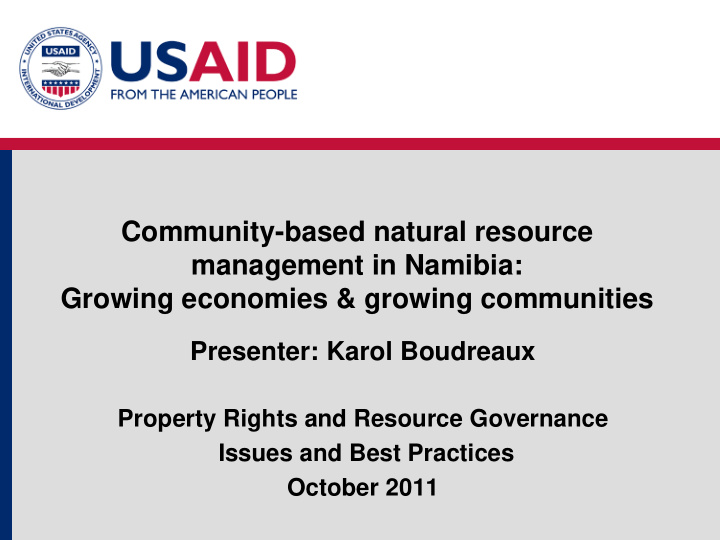



Community-based natural resource management in Namibia: Growing economies & growing communities Presenter: Karol Boudreaux Property Rights and Resource Governance Issues and Best Practices October 2011
Namibia
Property rights to resources • Before, wildlife was government-owned, essentially open-access resource • Devolving takes a government “stick” and gives it to locals • Thickens bundle held by locals • Thicker bundles shifts incentives to conserve • Encourages entrepreneurship
Goals for CBNRM in Namibia: 1. Conserve natural resources/wildlife 2. Promote economic development 3. Build local governance institutions 4. Empower via ownership & knowledge
Background to CBNRM in Namibia • White farmers gains rights to manage wildlife in 1970s • Community game guards in 1980s • Support from traditional authorities • Legal environment changes through legislative amendment in 1996 • Rights to manage & benefit from wildlife devolved to local communities • Generally strong institutional environment 6
Institutional changes • Shift away from poaching in 1980s – NGO provides incentives to shift – Traditional authorities support change • Independence in 1990 • Strong Ministerial support • Legislative amendment of 1975 Nature Conservation Ordinance enacted in 1996 7
Drivers of institutional change • Internal support within Ministry of Environment & Tourism • Local support from communities, esp. traditional leaders • External support from local NGOs – NWT & IRDNC • External support/funding from WWF/USAID’s LIFE project, EU & UNDP 8
Nature Conservation Amendment Act of 1996 • Specifies conditions for conservancy formation and creates new rights – Defined border; defined membership; management committee; constitution; provisions for equitable distribution of benefits – Own-use rights, capture & sell, cull, manage, trophy hunting and non- consumptive use rights (tourism) 9
Management committees: Local definition/local control • Create & maintain membership lists • Draft constitution • Create game management plans • Create dispute resolution strategies/mechanisms • Hold annual meetings • = local democracy/micro-level rule of law? 10
Women make up 37% of conservancy committees (up from 30% in 2003) Source: IRDNC Asst. Director John Kasaona 11
12 NACSO, State of the Conservancies, 2009
13 NACSO, State of the Conservancies, 2009
14 NACSO, State of the Conservancies, 2009
Lodges create local partnerships 15
Jobs created through CBNRM activities In 2006 : 742 full-time jobs 5153 part-time jobs Source: IRDNC Asst. Director John Kasaona 16
17 NACSO, State of the Conservancies, 2009
Human/social capital improving • Learning/skills – Job training (service) – Training in wildlife mgmt (event books) – Business management – Leadership skills Crosley started as a • Local governance waiter, became a guide and is training • Households stay together to be a manager at • Communities seem Grootberg Lodge stronger 18
19 NACSO, State of the Conservancies, 2009
From another region Source: NACSO, State of the Conservancies, 2007 20 http://www.nacso.org.na/SOC_2007/index.php
21 NACSO State of the Conservancies 2009
Is this model replicable? • Paradigm is strong • Devolution to communities a key part of the success • Highlights need for coaltion building • External (NGO/donor) support essential in this case for capacity building • Long-term commitment issue 22
Conclusion • Long-term (20+ year) view essential • Good results may depend upon broader institutional environment • Consider devolution to lowest level • Control over resources should be as complete as possible 23
Thank you! 24
Recommend
More recommend